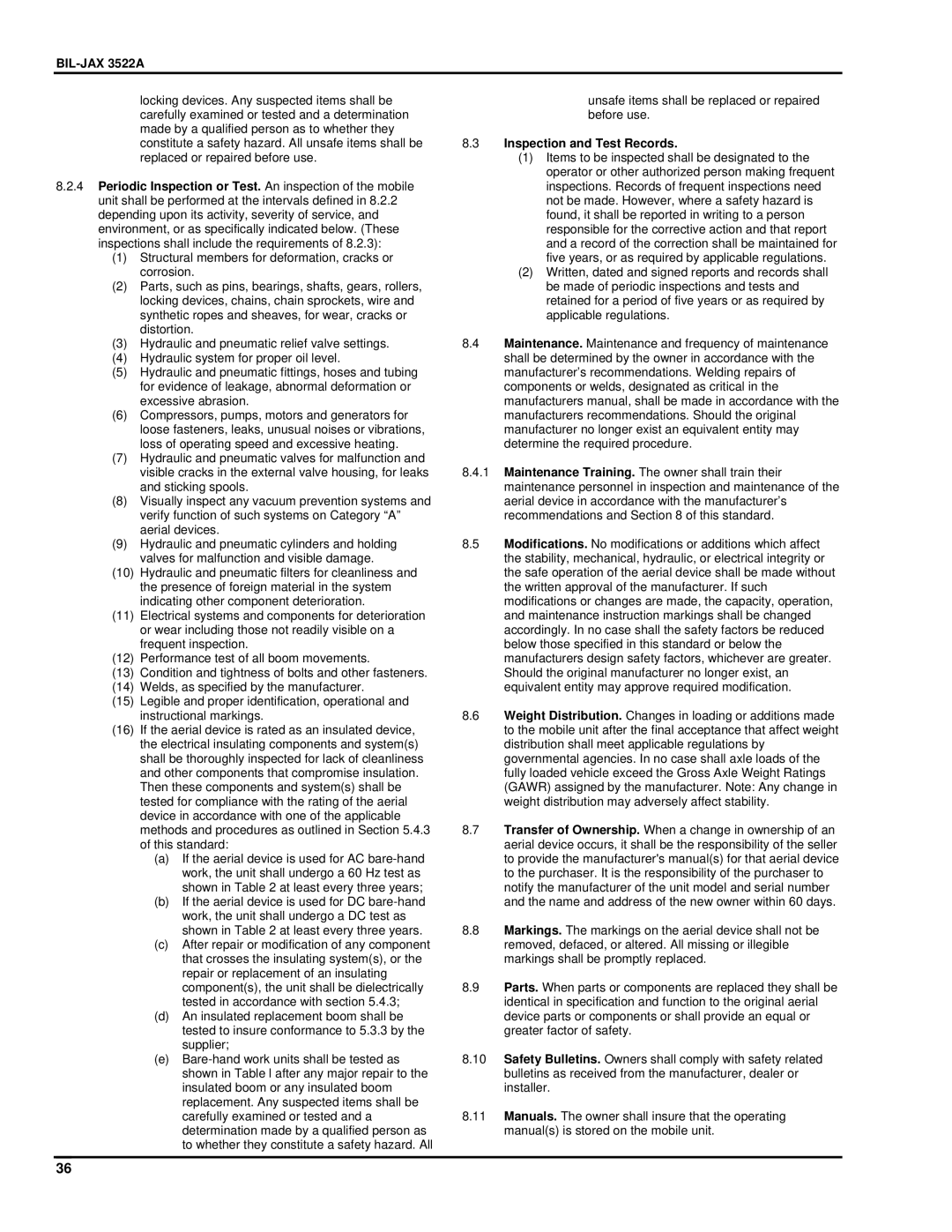
BIL-JAX 3522A
locking devices. Any suspected items shall be carefully examined or tested and a determination made by a qualified person as to whether they constitute a safety hazard. All unsafe items shall be replaced or repaired before use.
8.2.4Periodic Inspection or Test. An inspection of the mobile unit shall be performed at the intervals defined in 8.2.2 depending upon its activity, severity of service, and environment, or as specifically indicated below. (These inspections shall include the requirements of 8.2.3):
(1)Structural members for deformation, cracks or corrosion.
(2)Parts, such as pins, bearings, shafts, gears, rollers, locking devices, chains, chain sprockets, wire and synthetic ropes and sheaves, for wear, cracks or distortion.
(3)Hydraulic and pneumatic relief valve settings.
(4)Hydraulic system for proper oil level.
(5)Hydraulic and pneumatic fittings, hoses and tubing for evidence of leakage, abnormal deformation or excessive abrasion.
(6)Compressors, pumps, motors and generators for loose fasteners, leaks, unusual noises or vibrations, loss of operating speed and excessive heating.
(7)Hydraulic and pneumatic valves for malfunction and visible cracks in the external valve housing, for leaks and sticking spools.
(8)Visually inspect any vacuum prevention systems and verify function of such systems on Category “A” aerial devices.
(9)Hydraulic and pneumatic cylinders and holding valves for malfunction and visible damage.
(10)Hydraulic and pneumatic filters for cleanliness and the presence of foreign material in the system indicating other component deterioration.
(11)Electrical systems and components for deterioration or wear including those not readily visible on a frequent inspection.
(12)Performance test of all boom movements.
(13)Condition and tightness of bolts and other fasteners.
(14)Welds, as specified by the manufacturer.
(15)Legible and proper identification, operational and instructional markings.
(16)If the aerial device is rated as an insulated device, the electrical insulating components and system(s) shall be thoroughly inspected for lack of cleanliness and other components that compromise insulation. Then these components and system(s) shall be tested for compliance with the rating of the aerial device in accordance with one of the applicable methods and procedures as outlined in Section 5.4.3 of this standard:
(a)If the aerial device is used for AC
(b)If the aerial device is used for DC
(c)After repair or modification of any component that crosses the insulating system(s), or the repair or replacement of an insulating component(s), the unit shall be dielectrically tested in accordance with section 5.4.3;
(d)An insulated replacement boom shall be tested to insure conformance to 5.3.3 by the supplier;
(e)
unsafe items shall be replaced or repaired before use.
8.3Inspection and Test Records.
(1)Items to be inspected shall be designated to the operator or other authorized person making frequent inspections. Records of frequent inspections need not be made. However, where a safety hazard is found, it shall be reported in writing to a person responsible for the corrective action and that report and a record of the correction shall be maintained for five years, or as required by applicable regulations.
(2)Written, dated and signed reports and records shall be made of periodic inspections and tests and retained for a period of five years or as required by applicable regulations.
8.4Maintenance. Maintenance and frequency of maintenance shall be determined by the owner in accordance with the manufacturer’s recommendations. Welding repairs of components or welds, designated as critical in the manufacturers manual, shall be made in accordance with the manufacturers recommendations. Should the original manufacturer no longer exist an equivalent entity may determine the required procedure.
8.4.1Maintenance Training. The owner shall train their maintenance personnel in inspection and maintenance of the aerial device in accordance with the manufacturer’s recommendations and Section 8 of this standard.
8.5Modifications. No modifications or additions which affect the stability, mechanical, hydraulic, or electrical integrity or the safe operation of the aerial device shall be made without the written approval of the manufacturer. If such modifications or changes are made, the capacity, operation, and maintenance instruction markings shall be changed accordingly. In no case shall the safety factors be reduced below those specified in this standard or below the manufacturers design safety factors, whichever are greater. Should the original manufacturer no longer exist, an equivalent entity may approve required modification.
8.6Weight Distribution. Changes in loading or additions made to the mobile unit after the final acceptance that affect weight distribution shall meet applicable regulations by governmental agencies. In no case shall axle loads of the fully loaded vehicle exceed the Gross Axle Weight Ratings (GAWR) assigned by the manufacturer. Note: Any change in weight distribution may adversely affect stability.
8.7Transfer of Ownership. When a change in ownership of an aerial device occurs, it shall be the responsibility of the seller to provide the manufacturer's manual(s) for that aerial device to the purchaser. It is the responsibility of the purchaser to notify the manufacturer of the unit model and serial number and the name and address of the new owner within 60 days.
8.8Markings. The markings on the aerial device shall not be removed, defaced, or altered. All missing or illegible markings shall be promptly replaced.
8.9Parts. When parts or components are replaced they shall be identical in specification and function to the original aerial device parts or components or shall provide an equal or greater factor of safety.
8.10Safety Bulletins. Owners shall comply with safety related bulletins as received from the manufacturer, dealer or installer.
8.11Manuals. The owner shall insure that the operating manual(s) is stored on the mobile unit.
36
